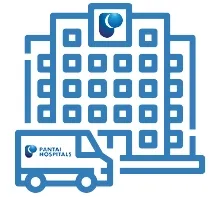The brain is a vital and complex organ with immensely intricate anatomy as different parts of the brain are responsible for different functions of the nervous system. Our brains are made up of billions of brain cells that communicate and coordinate every thought, movement, and function in the body.
The growth of abnormal cells in the brain is called a brain tumour. A brain tumour can develop in any part of the brain or skull, including the pituitary gland, base of the skull, protective lining of the brain, brain stem and various other areas.
What are the grades and types of brain tumours?
Brain tumours are categorised based on the growth rate and the relapse likelihood.
- Low grade: Grade 1 and 2 are non-cancerous (benign) brain tumours
- High grade: Grade 3 and 4 are cancerous (malignant) brain tumours
A primary brain tumour is a tumour that originates in the brain.
Secondary brain tumours or metastatic brain tumours are cancerous tumours that develop in other parts of the body and gradually spread to the brain.
Cancers that commonly spread to the brain include:
What are the causes and risk factors of developing brain tumour?
Most brain tumours have no known cause, but several risk factors can increase your chances of developing a brain tumour.
- Age: Brain tumours can affect individuals of any age, including children, but they are typically more prevalent in older people (85 to 89 years old).
- Radiation: In rare instances, brain tumours are due to exposure to radiotherapy, X-rays, or CT scans of the head.
- Genetic condition or family history: Genetic conditions such as Neurofibromatosis and Turner syndrome can increase the risk of developing brain tumours.
What are the signs and symptoms of brain tumour?
The symptoms of a brain tumour will vary depending on the type, grade, size, and location of the tumour:
- Headaches: Severe headache that worsens with activity or upon waking up in the morning
- Seizures: Seizure causes temporary changes in muscle tone or movements (twitching, stiffness, limpness), sensations, behaviour, or states of awareness
- Confusion and memory loss
- Numbness, weakness, and paralysis in one part of the body
- Unexplained nausea and vomiting
- Mood swings and personality disorders: Becoming more irritable, feeling aloof and uninterested in activities, experiencing sudden mood fluctuations for no specific reason
- Fatigue or tiredness
- Loss of balance and dizziness
- Changes in speech
- Changes in vision: Eyesight getting worse, blurry vision, blind spots
What are the symptoms of brain tumour based on location?
Different parts of the brain are responsible for various functions. The following are some of the common symptoms seen in different parts of the brain. The symptoms of a brain tumour will vary depending on the type, grade, size, and location of the tumour.
Responsible for your personality and movement control.
Symptoms:
- Weakness on one side of the body
- Difficulty walking
- Speech and sight problems
- Loss of smell
- Changes in behaviour and personality
Stores memories and processes sounds.
Symptoms:
- Hearing difficulty
- Short-term memory loss
- Hearing voices in your head
- Speech difficulties
Aids in object recognition and information storage.
Symptoms:
- Speech difficulties
- Difficulty understanding
- Difficulty writing or reading
- Loss of sensation in one part of the body
Responsible for processing what you see.
Symptoms:
- Changes in vision
- Difficulty in identifying object sizes and colours
Controls posture and balance of the body.
Symptoms:
- Dizziness
- Coordination and balance problems
- Uncontrolled eye movements
Produces hormones for body function.
Symptoms:
- Infertility
- High blood sugar (diabetes mellitus)
- High blood pressure (hypertension)
- Weight gain
- Mood changes
- Milk leakage from the breast when you are not breastfeeding
Plays an important role in regulating body functions such as breathing.
Symptoms:
- Double vision
- Difficulty speaking and swallowing
- Difficulty walking and unsteadiness
The spinal cord extends from the brain to the lower part of the back, and a tumour in the spinal cord can affect different parts of the body.
Symptoms:
- Loss of bowel and bladder control
- Numbness or weakness
Responsible for the production of the hormone melatonin.
Symptoms:
- Headaches
- Double vision
- Tiredness
- Difficulty in walking
How do doctors diagnose a brain tumour?
Diagnosis is made based on various investigations. Your doctor would first question your general health and conduct a neurological exam to check your hearing, vision, balance, coordination, and reflexes. Blood tests may be requested.

In addition, your doctor may request the tests below to aid in the diagnosis.
- Magnetic resonance imaging (MRI)
- MRI is done to have a detailed view of the brain, including the tumour’s size and exact position in detail. This takes approximately 30-60 minutes and does not use harmful radiation.
- Certain specialised types of MRI (MR angiography and MR spectroscopy) may be used to look at the brain's blood vessels and chemical activities.
- Computed Tomography (CT) scan
- A CT scan is offered as an alternative to MRI and is used to look for changes in the skull.
- It can also be used to look for bleed and enlargement in the brain's fluid-filled spaces (ventricles).
- Patients who cannot get an MRI or those who have pacemakers would have to undergo a CT scan.
- Biopsy
- A biopsy can be done to determine the nature of cancer (malignant or benign).
- Samples may be extracted during surgery to remove the tumour, or a stereotactic biopsy may be performed by creating a small hole in the skull for removal of tissues using a needle.
- Spinal tap (lumbar puncture)
- Spinal tap is performed to remove cerebrospinal fluid (CSF) from around the spine to detect cancer cells when the tumour cells are suspected to have invaded the meninges.
Learn more about the different types of screening and diagnostic procedures performed to diagnose brain tumour.
How is a brain tumour treated?
The treatment for a brain tumour depends on:
- Location and size of tumour
- Grade and type of tumour
- Your overall health
Prior to treatment, discuss with your doctor the objectives outlined in the treatment plan. Additionally, you should consult your doctor about the potential adverse effects of the treatment plan and options for palliative care.
- Surgery
- Surgery is one of the main treatments for brain tumours.
- It is performed to remove the entire tumour or to limit the growth of the tumour by removing a part of the tumour.
- Surgery may not be suitable if the tumour is located in inoperable regions of the brain.
- Chemotherapy
- Chemotherapy is a cancer treatment that employs potent cancer-killing medications.
- Chemotherapy can be given before surgery to shrink tumour size and after surgery to destroy the remaining cancer cells and to reduce the rate of spread of cancer.
- Chemotherapy can be given in combination with radiation therapy.
- Radiation therapy (radiotherapy)
- Radiation therapy destroys cancer cells with high-energy radiation. It is usually used for the tumour and the surrounding area of healthy brain tissue, the whole brain, or the spinal cord.
- Gamma Knife Radiosurgery is a form of radiation therapy that uses 192 precise laser beams of radiation to target a tumour. It also acts as an alternative therapy to chemotherapy, surgery, or other forms of radiation therapy. It is used to treat brain tumours that have metastasised to the brain and for both benign and malignant brain tumours.
- Palliative care
- Palliative care will be considered in situations where treatment is not recommended, or cancer cannot be treated completely. The goal is to maximise the quality of life by minimising signs and symptoms of cancer.
Learn more about the different types of treatment technologies to treat brain tumour.
What can I do to prevent and reduce the risk of developing a brain tumour?
As of present, there are no recognised effective methods for preventing brain tumours. Nevertheless, avoiding smoking and living a healthy lifestyle may lower the risk of developing a brain tumour.
Do I need to get screened for a brain tumour?
There are currently no screening procedures available for brain and spinal cord tumours. However, genetic counselling may be recommended if a first-degree biological relative (sibling or parent) has been diagnosed with a brain tumour. Frequent physical examinations and other tests may also be advised by your doctor if you have been diagnosed with genetic disorders that may increase your risk for brain tumours.
Make an appointment at Pantai Hospitals
Early detection of brain tumour makes it easier to treat the disease with effective and appropriate treatment. A dedicated multidisciplinary team of specialists and oncologists at Pantai Hospitals is available for consultation to provide the best care and assistance to patients through screening, diagnosis, and treatment.
Get in touch with us to book an appointment today if you have any concerns or questions about brain tumour treatment options.
Pantai Hospitals have been accredited by the Malaysian Society for Quality in Health (MSQH) for its commitment to patient safety and service quality.


 Request an Appointment
Request an Appointment.webp?sfvrsn=276ce14_1/vector-(3).webp) International Patient
International Patient

.webp)

 Find A Doctor
Find A Doctor



.webp?sfvrsn=20763f7d_21)
.webp?sfvrsn=f2a2c343_12)





